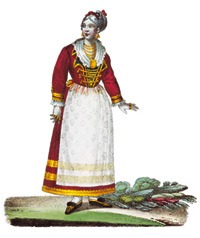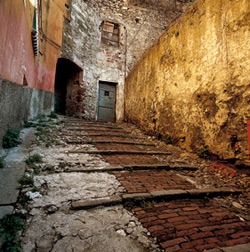
The recipe for “pesto” (or “ a taste of garlic” as it was also called) which is included in the book is the following:
“Take three or four cloves of garlic, basil , (which can be replaced by marjoram and parsley if it is difficult to find), and Edam and Parmesan cheese, grated and mixed together. Put them into a mortar and crush them with a pestle until the ingredients form a paste. At this point, add a good dose of a fine olive oil. This sauce is used to dress “gnocchi, troffie or trofiette” (kinds of pasta made principally of flour and potatoes), “lasagne” ( a kind of flat, square pasta) or “tagliolini” (a kind of pasta made of flour but also eggs). A little hot water is added to the sauce to make it more liquid”.
The differences which can be noticed between this recipe and the one we use today are: the use of Edam cheese or Gouda, which was popular in Genoa because of the maritime trade which existed at the time with countries of Northern Europe, and the choice which is conceded between the use of basil or marjoram and parsley. This latter choice was due to the difficulty of finding basil all year round.
In Casaccia’s Italian/Genoese dictionary whose second edition goes back to 1876, we can find:
“Pesto: our own, local word, which has no exact Italian translation, and is a kind of sauce or dressing, made up of basil, or marjoram and parsley , and of garlic and cheese, blended together in the mortar and lengthened with oil and some of the water used to cook the pasta”.
As can be seen, the recipe is more or less the same, but there is no precise indication of the cheese to be used.
Another interesting quote can be found in the book “The eating habits of Ligurian People: a gastronomic itinerary from Nice to Lerici”, written by Massimo Alberini and published in 1965 by Longanesi.
Alberini underlines how it is very important, when making pesto, to use a good extra-virgin olive oil from Liguria which is “of great finesse and exquisite aroma”. An oil which is ”full of taste without being heavy, a yellow-gold colour with emerald hues, very delicate and genuine”.
It is interesting when he analyses the origins of pesto as “a derivation of the ancient garlic sauce, used by the common people in the Middle Ages, and made up of squashed garlic cloves” and he emphasizes – when talking about it – how Rossi was rather sparing and vague about the quantity of basil to use, just a few leaves, while the quantity of garlic was abundant (three or four cloves).
 Some Quotation
Some Quotation
-What is “Pesto”?
-It’s easy to explain: you need a clove of garlic, basil, Sardinian cheese, a good mortar for the mixture and a fine oil to lengthen it!
-And the measures?
-My dear, see for yourself and I hope you are lucky!
“Because – as famous Rosso, first waiter and then partner of the Trattoria Monterosa behind Piazza Fontane Marose, used to say– to make a good Pesto sauce you have to be born in the right place, like a poet”.
This is what Alessandro Veraldo wrote with regard to “Genoese Cooking” in the rare “Cooking Almanac of the Italian Scene” published in 1937, when speaking of Ligurian eating habits.
And he added: “Pesto sauce, gentlemen, is like a Genoese flag: it competes with the Red Cross (the Genoese coat-of-arms carries a red cross on a white background). And with Saint George (Patron Saint of Genoa).
Pesto then, or Genoese mixture, is the classic, unsurpassable dressing, a kind of panacea: “Just pronouncing it would calm a riot on board ship”, so I was told by an old sailor who was at the command of a steamship of immigrants at the time of Edmondo de Amicis’s “Oceano”.
“Oil wins over the sea and Pesto wins over long faces!” he said.
When someone, from the farthest parts of the world, meets a Genoese, in order to demonstrate all his personal Ligurian culture, he speaks about Pesto. It’s a sort of word of honor.
Apart from the color which pervades these lines, they truly reflect the behavior of the Genoese of this period towards their loved sauce.
